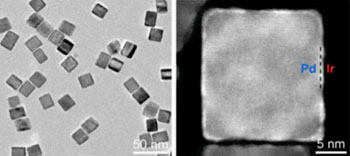Peroxidase Mimic Outperforms Natural Horseradish Peroxidase in ELISA Test
By LabMedica International staff writers
Posted on 30 Sep 2015
A test-of-concept study demonstrated that a synthetic catalyst that mimics the action of horseradish peroxidase (HRP) could increase the sensitivity of a colorimetric enzyme-linked immunosorbent assay (ELISA) for human prostate surface antigen (PSA) by more than 110-fold.Posted on 30 Sep 2015
Peroxidase mimics with dimensions on the nanoscale have received great interest as emerging artificial enzymes for biomedicine and environmental protection. While a variety of peroxidase mimics have been developed recently, limited progress has been made toward improving their catalytic efficiency.

Image: A new catalyst that improved the sensitivity of the standard PSA ELISA test by about 110-fold was made of palladium nanocubes coated with iridium (Photo courtesy of Dr. Xiaohu Xia, Michigan Technological University).
In a study published in the September 3, 2015, online edition of the journal ACS Nano, investigators at Michigan Technological University (Houghton, USA) and colleagues at Louisiana State University (Baton Rouge, USA) and the University of Texas at Dallas (USA) described a novel peroxidase mimic made by depositing Ir (iridium) atoms as ultrathin skins (a few atomic layers) on Pd (palladium) nanocubes.
These Pd–Ir nanocubes exhibited significantly enhanced efficiency, with catalytic constants more than 20- and 400-fold higher than those of an older version of Pd cubes and horseradish peroxidase (HRP), respectively.
In a proof-of-concept demonstration, the Pd–Ir nanocubes were used in a colorimetric ELISA for human prostate surface antigen (PSA). The modified assay was found to have a detection limit of 0.67 picograms per milliliter, which was about 110-fold lower than that of the conventional HRP-based ELISA using the same set of antibodies and the same procedure.
The Pd–Ir nanocubes were prepared by chemists at the Michigan Technological University. Investigators at Louisiana State University conducted theoretical calculations, and colleagues at the University of Texas at Dallas obtained high-resolution electron microscopy images.
"After surgery, it is vital to detect a tiny amount of prostate antigen, because otherwise you can get a false negative and perhaps delay treatment for cancer," said senior author Dr. Xiaohu Xia, assistant professor of chemistry at Michigan Technological University. "We wanted to develop a mimic peroxidase that was substantially more efficient than the natural peroxidase, which would lead to a more-sensitive PSA test. Our ultimate goal is to further refine our system for use in clinical diagnostic laboratories."
Related Links:
Michigan Technological University
Louisiana State University
University of Texas at Dallas










 (3) (1).png)



